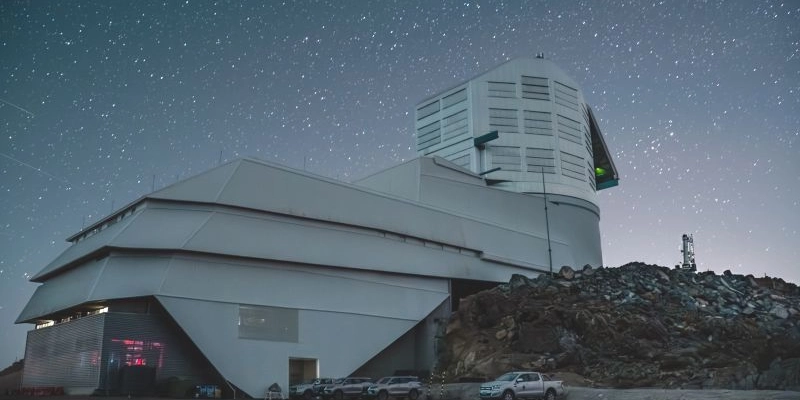Discover the First Images from the Vera C. Rubin Observatory: A Journey into the Universe

This Monday, June 23, 2025, the Vera C. Rubin Observatory took our breath away with its official “first light” images. Imagine opening your eyes after a long slumber and discovering a universe so sharp that every pixel seems to tell its own story. With a 3.2-gigapixel resolution—twice that of any other ground-based camera—Rubin captured nebulae like the Trifid and the Lagoon in a single mosaic as wide as 45 full moons lined up, revealing gas and dust details that were previously hidden in the shadows. It was like going from a dim flashlight to a stadium spotlight: every star, every filament of galactic dust, shone with breathtaking clarity.
Reveal the hidden universe: see the Rubin Observatory’s first light
Rubin’s adventure began on April 14, 2015, when the first stone was laid atop Cerro Pachón, Chile. Over the next nine years, engineers and astronomers drafted blueprints, excavated the mountain, and polished mirrors over eight meters across—so flawless they recall cut crystal. In October 2024, the engineering camera made its trial runs: a dress rehearsal for the real star of the show, the LSSTCam. From that moment on, every mechanism, every CCD sensor, and every beam of light was calibrated to the last micron—ready to redefine what we thought possible.
From 0 to 3.2 GPixels: meet the world’s largest camera
Why Cerro Pachón? At 2,700 meters above sea level, the air is as pure as on a glacier, letting starlight travel without turbulence or moisture. With over 250 clear nights a year, this Chilean peak is like an exclusive balcony on the cosmos—each night shines with the intensity of a brightly lit shopping mall. Plus, a freestanding concrete pillar isolates the telescope from even minor tremors, and a fiber-optic link sends 20 terabytes of data each night to California—a data torrent equivalent to streaming your favorite HD series 10,000 times in a row!
The crown jewel is the LSSTCam, the world’s largest digital camera: 3.2 GPixels, 9.6 square degrees of field of view—the size of a football stadium—and 189 CCD sensors that read every point of light in under two seconds. Picture a heavy‐duty freight truck next to a compact car: that’s how vast the gap is compared to cameras like Pan-STARRS (1.4 GPixels) or Subaru’s Hyper Suprime-Cam (0.87 GPixels). LSSTCam not only delivers more megapixels but captures a field 20 times larger in each exposure—like seeing the entire sky at once.
45 full moons in a single shot: welcome to astronomy’s new era
As you can see in the observatory gallery image, this cosmic mosaic contains about 10 million galaxies in a single exposure—roughly 0.05 % of the nearly 20 billion galaxies Rubin will survey over the next decade. Each point of light is an entire star system, a treasure trove of clues about the universe’s formation and evolution. To explore every corner of this stellar tapestry in all its detail, download the “Cosmic Treasure Chest” in full resolution (14.1 GB) and dive into over 3.2 GPixels of pure galactic wonder.
In just ten hours of operation, Rubin detected more than 2 100 asteroids, including seven near-Earth objects that—though stealthy as celestial ninjas—pose no threat. It was like finding flecks of gold in an endless desert: each drifting rock offers hints about our Solar System’s origins and helps map safe trajectories against potential impacts. Thanks to LSSTCam’s rapid readout, these bodies are identified instantly, turning each night into a planetary defense patrol.
But Rubin’s ambition goes beyond asteroids. Over the next ten years, this 8.4-meter telescope will generate more than 200 petabytes of data—enough to fill 10 million DVDs—creating the universe’s first true “time-lapse” film. We’ll watch supernovae ignite like distant flares, hidden galaxies emerge from the darkness, and dark matter sketch its invisible web with unprecedented precision. Each frame will be a window into the past, showing events that unfolded thousands—or even billions—of years ago.
Behind this astronomical colossus is a global partnership: the U.S. National Science Foundation (NSF) and the Department of Energy (DOE) funded the project, while AURA (Association of Universities for Research in Astronomy) managed construction and SLAC National Accelerator Laboratory designed the LSSTCam. Over 60 academic institutions worldwide are lending their expertise so that, beginning in 2027, the data will be open to scientists and enthusiasts alike—democratizing access to discoveries that could answer questions as old as “How did it all begin?”
If you’re passionate about astronomy and dream of exploring the cosmos from your screen, there’s never been a better time to join this adventure. The Vera C. Rubin Observatory doesn’t just redefine what we can see—it revolutionizes how we see it, with unprecedented clarity, an exceptional field of view, and a readout speed that anticipates discoveries in real time. Subscribe to our blog to get each new image, each breakthrough, and every step of this cosmic journey as it unfolds.

